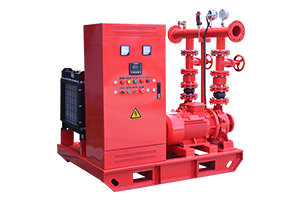How to Retrofit an Existing Fire Pump System?
Dec 02, 2024
Share:
Retrofitting an existing fire pump system involves upgrading or modifying the system to improve performance, meet updated codes, or address new requirements. Here’s a step-by-step guide:

1. Assess Existing System
- Inspection: Evaluate the current system, including the pump, motor, driver (electric or diesel), piping, valves, and controllers.
- Performance Testing: Conduct flow and pressure tests to measure pump performance against requirements.
- Compliance Check: Verify compliance with current standards like NFPA 20, local fire codes, and insurance requirements.
- Identify Issues: Pinpoint inefficiencies, wear, or components nearing the end of their lifespan.
2. Define Objectives
- Code Compliance: Ensure the system meets updated safety and building codes.
- Capacity Increase: Upgrade for higher flow rates or pressures if required.
- Energy Efficiency: Install more efficient motors or variable frequency drives (VFDs) to reduce energy consumption.
- Technology Integration: Add modern controllers, sensors, or automation for remote monitoring and management.
3. Design the Retrofit
- Consult Professionals: Engage fire protection engineers or system designers to create an upgrade plan.
- System Layout: Plan changes to accommodate new components or expand capacity.
- Equipment Selection: Choose UL-listed, FM-approved, or equivalent components for reliability and compliance.
4. Upgrade Components
- Pump Replacement/Upgrade: Swap outdated pumps for newer models or retrofit with improved impellers.
- Driver Upgrades:
- Replace electric motors or diesel engines with higher efficiency models.
- Add backup power systems if necessary.
- Controller Modernization: Upgrade to controllers with digital displays, diagnostics, and communication capabilities.
- Piping and Valves: Replace corroded or undersized pipes and install reliable control valves.
5. Install Additional Features
- Jockey Pump Installation: Ensure steady pressure in the system.
- Monitoring Systems: Add pressure transducers, flow meters, or internet-enabled remote monitoring systems.
- VFDs: For electric systems, VFDs provide soft starts and variable speed control.
6. Testing and Commissioning
- Hydrostatic Testing: Verify the integrity of pipes and connections.
- Operational Testing: Perform a full system test to confirm proper operation under normal and emergency conditions.
- Flow Testing: Ensure the fire pump meets the required flow and pressure.
7. Documentation and Training
- System Manuals: Update documentation to reflect changes made during the retrofit.
- Training: Train personnel on new equipment and systems.
8. Schedule Regular Maintenance
- Routine Checks: Set a schedule for periodic inspections and testing to ensure ongoing reliability.
- Compliance Updates: Stay informed about changes in fire codes to keep the system compliant.
A well-planned retrofit can improve system performance, reduce downtime, and enhance safety, ensuring your fire protection system is robust and ready for any emergency.






